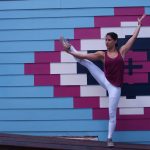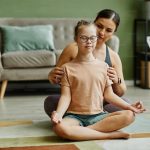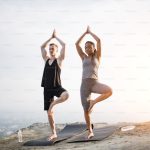Downward Facing Dog is another iconic yoga pose and one that most yogis will be introduced to in their first yoga class. Having said that, it is far from easy and requires strength and flexibility to be done well. Do you know how to teach a strong Down Dog? Here’s how you do it.
Getting Down to Business
Downward Facing Dog (or adho mukha svanasana) is another pose that we use as a transition in vinyasa and sun salutes as well as a pose in its own right. It is most frequently entered from chaturanga dandasana or Child’s Pose on the way to uttanasana or a Warrior Pose. It accesses the fascial connections of the superior backline of the body so stretches the hamstrings and calves beautifully. It strengthens and opens the shoulders in preparation for many other asanas at the same time as it works on the core. It is such a wonderfully versatile pose — I sometimes think I could theme a whole class around Down Dog.
Though traditionally considered a rest pose, Down Dog is by no means a chance to relax. From fingertips to toes there is a multitude of muscle engagements and energetic actions to remember. So where should students focus in Down Dog? Let’s take a look…
See Also: Everything Yoga Teachers Need to Know About Fascia
- Hands — Spread and ground through the thumb side of the hand and fingers with a feeling of lift in the palm and lightness under the wrists. Cueing attention to the fingers and encouraging the wrist flexors to engage here helps to prevent dumping the weight through the wrists.
- Elbows — Micro bend with the elbow creases striving to point forwards.
- Shoulders — Draw the shoulder blades around the chest wall using serratus anterior and externally rotate the arms. David Keil describes a lovely routine to achieve this:
- Step 1: Bend the elbows.
- Step 2: Squeeze the bent elbows together as if you are holding a beach ball between them.
- Step 3: Slowly straighten the arm to the micro bend keeping the ball squeezed.
If the shoulders are still pushing up into the ears, a cue to draw the shoulder blades gently together and down towards the waist at the same time activates the lower trapezius to balance serratus anterior in this position.
- Spine — Aim to maintain normal curves along the whole length (i.e. a small lumbar lordosis, thoracic kyphosis, and the head relaxed, looking up). Cue length through the spine from the crown of the head to the tailbone.
- Pelvis —Pelvis lifts skyward as the heels sink to the floor
- Hips — With a slight internal rotation, draw them together using the adductors as the glutes activate to draw the upper thighs back. Many students sort of hang here rather than working on getting really active, engaged legs.
- Knees — Micro bend with quads activated to relax the hamstrings through reciprocal inhibition
-
Heels — Sink the heels to the floor as the tibialis anterior on the front of the shins activates. The calves are relaxing here through reciprocal inhibition again. Cueing heels turned out a little helps activate the whole inner spiral of the leg.
- Bandhas — Engagement of the uddiyana and mula bandhas stabilises the pose and helps to lift the pelvis a little higher.
- And breathe… with so much to work on, holding the breath can be a problem. A really deep sigh here works wonders to relax the diaphragm and reset deep, slow breaths.
Preparation and Modifications
As I said, there is lots to think about and not every student will be able to focus on everything at the same time, so there is real mileage in breaking down the pose and working on a few elements at a time.
- Puppy Pose is a great place to work on getting the right combination of actions in the hands, arms, and shoulders.
- Dolphin really works the shoulders and can be useful for students with hand and wrist problems that prevent the full expression of Downward Facing Dog.
- Tadasana and Plank use the same muscle engagements as Down Dog and preparation work here pays dividends in the full expression.
- Walk the Dog, or alternating stretching and bending the legs, uses less muscle action than Down Dog and is a great way to lengthen the fascial structures on the back of the body and help to stretch the hamstrings and calves. I use this a lot in my warm-ups or in gentle versions of sun salutes.
And Now For a Challenge…
Downward Facing Dog can be used as a foundation pose for some lovely strengthening work in intermediate or advanced classes. Strong students love some of these:
- Three-Lgged Dog — A personal favourite. Inhaling one leg slowly up to make a straight line through the shoulder, hip and heel. Holding here while pushing out through the heel really activates the core and hip extensors. Can be used as a standalone pose or before the stepping forwards phases of sun salutes.
- Twisted dog — Start as for three-legged dog then bend the lifted knee, taking the heel towards the bottom before dropping that foot over the opposite hip. This works the core as well as opening the front of the raised hip. Moving on into wild thing from here adds a little bit of fun for anyone wanting to try it.
- Plank to down dog pulses — Slowly move from plank into down dog and back again. Keeping all of the muscle engagement is wonderful for strengthening the core and shoulders. A few pulses of this really ups the ante in a power yoga class.
- Knee to chest — From Downward Facing Dog, draw one knee into the chest as the body lowers into a plank position then back again. This can be advanced further by moving into three-legged dog as a start and finish position. Another personal favourite when aiming to work the core and shoulders hard.
A Victorious Downward Facing Dog
I love Down Dog and all of its variations. It is such a useful tool in classes and achieves so much in a short space of time. Moving really slowly in and around this pose can be really meditative and, as it is an inversion too, it brings the calming elements alongside the hard work which is a lovely bonus. I’m feeling really inspired now — maybe I will do that Down Dog-themed class this week. Fancy joining me?












